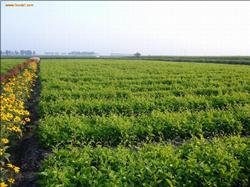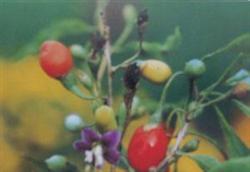Construction of fast-growing Lycium barbarum forest

Lycium barbarum has strong adaptability, can tolerate cold, drought and saline-alkali, and can grow in sandy loam, loam, loess and sandy wasteland. Chinese wolfberry likes cool climate, light and fat. Second, the method of reproduction Lycium barbarum flowers solitary or several clusters in leaf axils, Corolla pink or mauve, and with dark purple veins; pedicel fine; calyx bell-shaped. The berries are oval or oval and red or orange when ripe. Most of the seeds (20-50), flat kidney-shaped, yellow-white. The flowering period is from May to October and the fruiting period is from September to November. The sprouting ability is very strong, the new branches can sprout every month from April to August, and the flower buds are mixed buds. Axillary, Lycium barbarum mostly bear fruit on 12-year-old branches. The propagation method of Lycium barbarum is mainly seed propagation, but also can be propagated by cutting and tillering. 1. Seed propagation (1) the best choice of seedling site is sandy loam with deep soil layer, fertile soil, good drainage, flat terrain, sufficient sunshine, neutral or slightly alkaline. The soil should be prepared carefully before sowing, the seedling land should be turned deep twice, leveled and raked fine, sown in a high border with a width of 1.3 meters, and drainage ditches should be made around. In combination with soil preparation, more base fertilizer should be applied, 25003000kg of barnyard manure per mu. (2) the fine varieties with more than 6 years old, strong growth, red fruit and no diseases and insect pests were selected as the mother plant for seed collection and seed treatment, and picked in time from September to November when the fruit changed from edge to red. After collecting the seeds, soak them in 30 ℃ 50 min warm water for 24 hours, remove and knead them, wash them in clean water, remove the flesh and skin, take the seeds to dry and sow them immediately. If you do not sow for the time being, mix the seeds with 3 times as much wet sand, put them in a wooden box and place them in a 20 ℃ indoor layer to accelerate germination. In the spring of the second year, when 30%-50% of the seeds are white, take out and sow. (3) sowing can be sowed in spring, summer and autumn, and it is better to sow in late March in spring. On the whole seedbed, a shallow trench is opened horizontally according to the row spacing of 20ml / 30cm, with a depth of 2cm / 3cm and a width of 5cm. Then sow the budding seeds evenly into the ditch. If you use dried seeds, soak the seeds for 12 days, remove them and dry them, mix them with fine sand or plant ash and sow them. Cover fine soil after sowing, cover grass on the border after a little suppression, keep warm and moisturize. Use 150-200 grams of seeds per mu. (4) after the emergence of the seeds in the nursery management, remove the cover grass, timely irrigation to prevent drought, ploughing and weeding in time after water infiltration, as usual, it will be carried out 4 times a year. In combination with intercropping, the weak seedlings were pulled out for the first time at a height of about 5 cm, and the seedlings were retained according to the plant distance of 5m / m; the second time, in the first and middle of July, the seedlings were determined according to the plant spacing of 10m / 15cm, and urea or farm manure was applied to promote the growth of seedlings. When the height of the seedling is more than 60 cm, topping to accelerate the growth of the trunk and side branches. The seedlings raised in spring were planted in the nursery after autumn, while those raised in summer and autumn were irrigated with frozen water in winter and left the bed in the nursery after autumn in the following year. 2. Cuttings propagate after the sap flows in spring, before sprouting and releasing leaves, cut the overgrown branches or "seven-inch branches" from the fine mother tree into cuttings with a length of 38ml / 20cm, soak the cuttings with 500ppm rooting powder or 500-1000ppm indoptylic acid solution for a second, take them out and dry them, insert them obliquely into the seedbed according to the row spacing of 15 × 7cm, keep the bed soil moist and shade in a low shed, and the seedling rate can reach more than 80%. When the seedling height is about 80 cm, it can be planted out of the nursery. It can also be cut directly and strengthen the management of fertilizer and water after seedling, so that it can blossom and bear fruit in the same year. 3. The tillering propagation of Lycium barbarum has a strong tillering ability, and many tillering seedlings are often sent out around the root system, which can be dug up with roots in autumn and winter and planted separately. Third, the adaptability of planting seedlings and afforestation of Chinese wolfberry is strong. Before planting, the soil must be thoroughly and deeply turned into a soil preparation, and then planted according to the distance of 2 × 2 meters between rows and plants, which is arranged in a rectangle to facilitate farming. Colonization can be carried out from defoliation in autumn and winter to before seedling germination in the following spring, but the survival rate is higher from late March to early April in spring. When planting, dig holes 40 cm × 40 cm × 40 cm, apply 5 kg of rotten stable manure or compost to each hole, and cover fine soil with a thickness of 10 cm after mixing with the subsoil. When planting, the root system should be stretched, the topsoil should be filled, and the soil at the bottom of the pit should be filled on top, which is conducive to soil ripening. The method of three burying-trampling-promotion was adopted when planting. 4. Management after planting. 1. Interplanting with melons, beans, vegetables and other crops in the early stage of weeding. In the first 2-3 years after planting, field management measures such as loosening soil, weeding, irrigation and fertilization were carried out to promote the growth of young plants. 2Mel no longer intercropped after 3 years, generally turn the garden soil once from mid-March to early April, with a depth of 10cm, and turn the garden soil once again in mid-late August, with a depth of 20cm. It can preserve soil moisture and improve soil temperature, which is beneficial to the growth of root system. 2. Scientific and rational fertilization in the growing period in early May, early June and late September, respectively, topdressing mature human and animal manure water or urea, ammonium sulfate and other quick-acting fertilizers three times, each time digging holes next to the plant to apply 100 grams of urea, irrigation after application, cover the soil, in addition, 0.5% urea and 0.3% potassium dihydrogen phosphate were used for extra-root topdressing in May, June and July. Before filling frozen water in early November, dig holes or trenches around the rhizosphere, apply 20 kg of human and animal manure, 50 kg of soil fertilizer and 2 kg of cake fertilizer per plant, cover the soil and cultivate soil in the rhizosphere to survive the winter. 3. During the period from the growth of new branches and leaves to flowering and fruiting, irrigation should be done 4 times, next to the end of April to the beginning of May, and then every half a month. The high temperature in summer coincides with the fruit ripening period, and the dew volume is greater, so it should be watered once after each fruit harvest. During the growth period of autumn shoots, they were watered in early August, early September and early November respectively, and winter water should be watered twice before freezing. 4. Reasonable pruning in order to cultivate a high-yielding tree type with stable skeleton, round crown, ventilation and light transmission and three-dimensional results, according to the experience of the main producing area, it is best to adopt the "trunk hierarchical" tree type, with a height of about 2 meters. The main branches are distributed in three layers on the middle trunk, and there is a fixed spacing between each layer, and the main branches and the middle trunk are at a certain angle and open outward, ventilated and transparent.
- Prev

Control of Lycium barbarum Colletotrichum
Symptoms Lycium barbarum anthracnose commonly known as black fruit disease. It mainly damages green fruits, shoots, leaves, buds and flowers. Green fruit infected at the beginning of the fruit surface of small black spots or irregular brown spots, in case of continuous rain spots continue to expand, half fruit or whole fruit black, dry fruit cable shrink; humidity is large, a lot of orange colloidal spots grow on the diseased fruit; shoots, leaf tips...
- Next

Lycium barbarum has wide adaptability and easy to plant.
Lycium barbarum has strong sprouting power, and tillering seedlings grow from the roots while many new branches are sent out from April to August every year. Lycium barbarum is cold-tolerant, light-loving and saline-alkali tolerant. Its reproduction can be divided into sexual reproduction and asexual reproduction. Sexual reproduction will put the fruit into practical blisters for 2 days, soften and wash out the seeds to dry. Sowing in late March, covering 1 cm of soil.
Related
- Fuxing push coffee new agricultural production and marketing class: lack of small-scale processing plants
- Jujube rice field leisure farm deep ploughing Yilan for five years to create a space for organic food and play
- Nongyu Farm-A trial of organic papaya for brave women with advanced technology
- Four points for attention in the prevention and control of diseases and insect pests of edible fungi
- How to add nutrient solution to Edible Fungi
- Is there any good way to control edible fungus mites?
- Open Inoculation Technology of Edible Fungi
- Is there any clever way to use fertilizer for edible fungus in winter?
- What agents are used to kill the pathogens of edible fungi in the mushroom shed?
- Rapid drying of Edible Fungi

